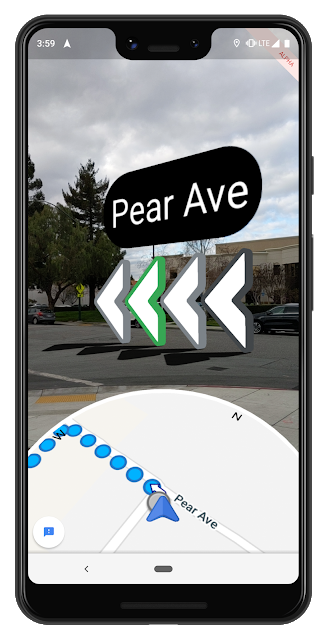Last month Google invited a select number of users and journalists to try out its new augmented reality functionality in Google Maps.
It is an exciting development particularly for those who have ever experienced difficulty finding a location in the real world when Google Maps’ blue dot fails to be accurate enough. But with local and hyperlocal SEO becoming a bigger consideration for businesses seeking to be visible in mobile search, are there implications here too?
How Google is bringing AR to its maps navigation
Back in February, Google invited a small number of local guides and journalists to try out the new AR functionality in its Google Maps service.
As is detailed over on the Google AI blog, they are calling the technique “global localization”. It aims to make Google Maps even more useful and accurate by building on its GPS and compass powered blue dot with added visual positioning service (VPS), street view, and machine learning.
The result incorporates AR and map data. When planning a route from A to B, users can use the smartphone lens to see the world in front of them with Google Maps’ location arrows and labels overlaid.

Challenges
Accuracy and orientation have always been the biggest challenge for real-time mobile mapping. GPS can be distorted by buildings, trees, and heavy cloud cover. Orientation is possible because mobile devices are smart enough to measure the magnetic and gravity field of the earth relative to the motion of the device. But in practice, these measurements are very prone to errors.
With VPS, street view, and machine learning added to the Google Maps’ route-planning functionality, the early reports are very positive. VPS works in tandem with the street view to analyze key structures and landmarks in the field of view. It is pretty much the same way we as humans process what we are seeing in relation to what we expect to see. Once it calibrates, the AR functionality presents the relevant route markers (arrows and labels) to show the user where to go.
Of course, there are challenges with this added technology too. The real world changes. Structures come and go, which can make it difficult for VPS to marry up what it sees, with what street view has indexed. This is where machine learning comes in, with data from current imagery being used to update, build upon, and improve what Google Maps already knows.
An additional challenge also concerns user habits. But Google has been quick to build in prompts to stop users from walking too far while looking through the AR lens minimizing any potential risk from real-world hazards (vehicles, people, structures, and the others) outside of the camera’s view.
Implications for search
When its AR functionality is rolled out, it’s not hard to see that Google Maps will have added appeal for users.
This is building on an already massively popular tool. According to data from The Manifest, 70% of navigation app users use Google Maps. As a proportion of the 2.7 billion global smartphone user base, this is around 1.4 billion people.
We’ve written at length here at Search Engine Watch about the importance of local and hyperlocal search. If you have a real-world location for your business and you have not already done so, setting up a “Google My Business” profile is the first step to assisting Google Maps with knowing exactly where your business location is. In addition, it also improves how you are presented in local search elements such as three-pack listings, as well as giving the user clear opening time information, and the option to click-to-call.
This is obviously important as more people come to Google Maps to use the AR functionality. On a hyperlocal level, as Google Maps’ AR looks to make increasing use of non-transient structures and landmarks, it might be good practice for businesses to make it more of a point to rank for key terms related to these landmarks. It is also easy to see how important it is to consider how your business looks from a joined-up marketing/UX perspective, with questions such as:
- Is your real-world branding clear and visible in the real world? (It might be from across the street, but how about from 100 paces away?)
- Is your real-world branding consistent with what it is being presented as online?
A positive step for users and SEOs
As a Google Maps user, this AR functionality is very exciting and I believe that it could have positive implications for SEO too.
For businesses who have real-world locations, Google Maps is already a hugely important way for potential customers to discover you and pay a visit. AR is a fascinating arena of digital technology, and we have already seen its impact through games such as “Pokemon GO“ and other AR mapping tools that are popular with users. Ultimately, in as much as search and navigation apps are lenses through which it pays to be visible, it seems AR will prove to be just as important when this technology is rolled out publicly.
Luke Richards is a writer for Search Engine Watch and ClickZ. You can find him on Twitter at @myyada.
The post Google tests AR for Google Maps: Considerations for businesses across local search, hyperlocal SEO, and UX appeared first on Search Engine Watch.
from Search Engine Watch https://ift.tt/2I4xjAH



No comments:
Post a Comment